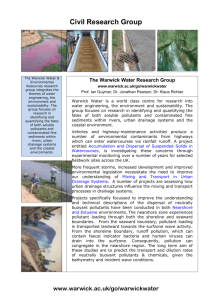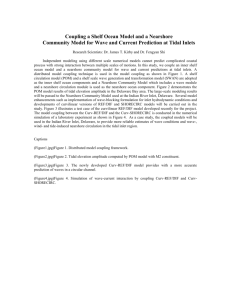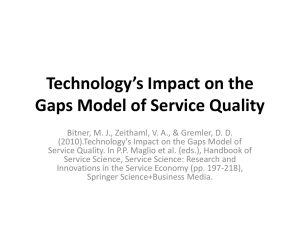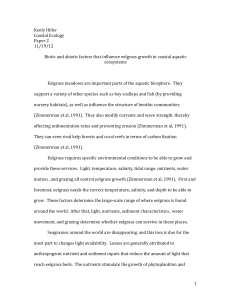Nearshore_Inventory_and_Gaps_-_Summary
advertisement
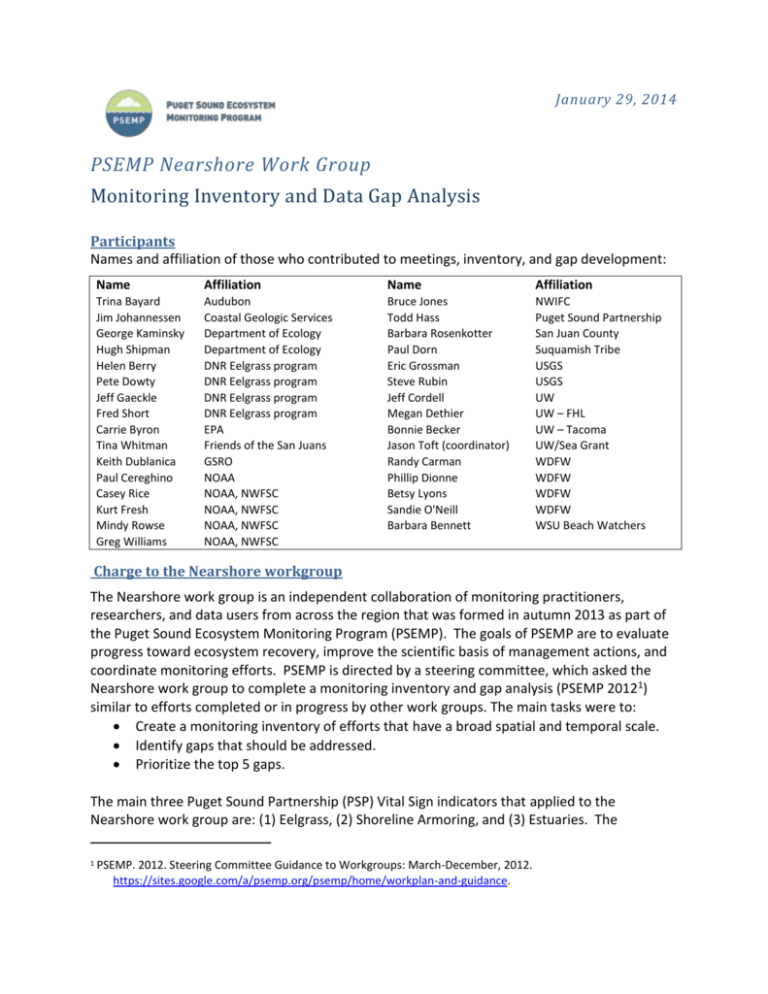
January 29, 2014 PSEMP Nearshore Work Group Monitoring Inventory and Data Gap Analysis Participants Names and affiliation of those who contributed to meetings, inventory, and gap development: Name Affiliation Name Affiliation Trina Bayard Jim Johannessen George Kaminsky Hugh Shipman Helen Berry Pete Dowty Jeff Gaeckle Fred Short Carrie Byron Tina Whitman Keith Dublanica Paul Cereghino Casey Rice Kurt Fresh Mindy Rowse Greg Williams Audubon Coastal Geologic Services Department of Ecology Department of Ecology DNR Eelgrass program DNR Eelgrass program DNR Eelgrass program DNR Eelgrass program EPA Friends of the San Juans GSRO NOAA NOAA, NWFSC NOAA, NWFSC NOAA, NWFSC NOAA, NWFSC Bruce Jones Todd Hass Barbara Rosenkotter Paul Dorn Eric Grossman Steve Rubin Jeff Cordell Megan Dethier Bonnie Becker Jason Toft (coordinator) Randy Carman Phillip Dionne Betsy Lyons Sandie O'Neill Barbara Bennett NWIFC Puget Sound Partnership San Juan County Suquamish Tribe USGS USGS UW UW – FHL UW – Tacoma UW/Sea Grant WDFW WDFW WDFW WDFW WSU Beach Watchers Charge to the Nearshore workgroup The Nearshore work group is an independent collaboration of monitoring practitioners, researchers, and data users from across the region that was formed in autumn 2013 as part of the Puget Sound Ecosystem Monitoring Program (PSEMP). The goals of PSEMP are to evaluate progress toward ecosystem recovery, improve the scientific basis of management actions, and coordinate monitoring efforts. PSEMP is directed by a steering committee, which asked the Nearshore work group to complete a monitoring inventory and gap analysis (PSEMP 20121) similar to efforts completed or in progress by other work groups. The main tasks were to: Create a monitoring inventory of efforts that have a broad spatial and temporal scale. Identify gaps that should be addressed. Prioritize the top 5 gaps. The main three Puget Sound Partnership (PSP) Vital Sign indicators that applied to the Nearshore work group are: (1) Eelgrass, (2) Shoreline Armoring, and (3) Estuaries. The 1 PSEMP. 2012. Steering Committee Guidance to Workgroups: March-December, 2012. https://sites.google.com/a/psemp.org/psemp/home/workplan-and-guidance. monitoring inventory and gaps were not limited to these, and identified nearshore gaps both related to and beyond the vital signs. Other PSEMP work groups operating a similar process have some conceptual overlap with the nearshore (e.g., birds, forage fish); communication with other work groups sought to limit redundancy of the inventories and establish potential overlap in gaps. Highlights of the Monitoring Inventory The Nearshore work group identified 21 monitoring programs that have a broad Sound-wide range and that are mostly ongoing active programs. A full listing can be found in the Excel Spreadsheet “Nearshore Monitoring Inventory.” Each program entry includes information on main objectives, measurements, legal mandates, estimated costs, funding source, location of reports and websites, and spatial and temporal scales. Lead agencies responsible for the programs represented a broad spectrum (WDFW, PSNERP, DNR, PSAMP, UW, NWFSC, NOAA, TNC, USGS, SRSC). A summary of the key components of the monitoring inventory shows that most programs have a component of status and trends and a link to one of the PSP Vital Signs and indicator measurements (Table 1): (1) Shoreline Armoring: Extent of shoreline armoring, evaluation of new, replacement, and removed armoring. (2) Eelgrass: Area of eelgrass, sites of increasing and decreasing coverage. (3) Estuaries: Area of estuarine wetlands restored to tidal flooding in Puget Sound’s large river deltas. Effectiveness monitoring is also covered by programs focusing on restoration monitoring at the major river deltas (Table 1; see full inventory for details). Some current monitoring programs also address indicators beyond the Vital Signs, such as (1) floating and understory kelp monitoring, (2) measurements of biotic diversity, and (3) measurements of physical and biological parameters at armored and unarmored sites, and at perennial stream deltas with varying urban gradients. Table 1. Summary of key components from the monitoring inventory. Topic Armoring Monitoring Program Name Puget Sound Shoreline Armoring Lead Agency WDFW Armoring PSNERP Armoring Inventory Compilation ShoreZone PSNERP Armoring DNR/PSAMP Short Description Evaluation of Hydraulic Project Approvals issued for shoreline armoring in Puget Sound. Compilation of Sound-wide armoring data. Comprehensive inventory of marine shoreline characteristics, including armoring. Armoring Armoring study: central, south, and north sound UW Biotic Diversity Intertidal biotic community monitoring Submerged Vegetation Monitoring Program DNR Kelp Floating and understory kelp DNR Biotic Diversity Urban Gradients NWFSC Estuary Restoration ESRP Delta Adaptive Management, including restoration monitoring at Stillaguamish, Nisqually, Skagit, and Snohomish deltas WDFW/NOAA, TNC, USGS, SRSC Eelgrass DNR Study of numerous physical and biological parameters at paired armored and unarmored beaches. Low-shore detailed biotic surveys (SCALE study). Annual monitoring of Puget Sound eelgrass area and depth distribution. Annual aerial photographybased mapping of canopy extent. Study at small perennial streams that flow directly into Puget Sound with varying degrees of land-use impairment. An effort to define monitoring goals and fund efforts to inform capital investments in delta restoration. Highlights of the Gaps Based on the inventory of existing monitoring, the Nearshore work group identified 26 gaps in our knowledge of the system. A full listing can be found in the Excel Spreadsheet “Nearshore Priority Gaps.” Each entry includes information on what the gap is, why it is important, the approximate cost, and other notes. There is a large range in gaps identified, including gaps related to the PSP Vital Signs as well as gaps beyond the Vital Signs. Some gaps identified beyond the Vital Signs include (1) other physical and biological covariates of ecosystem function such as measurements of substrate composition and biotic diversity, (2) understanding of ecosystem processes and functions involving stressors, drift cells, thresholds, and linkages, (3) integrated frameworks for data management, (4) other features of the nearshore such as kelp, riparian vegetation, and driftwood, (5) understanding of predicted changes such as sea-level rise on estuarine habitat, and expansion of aquaculture activities, and (6) a survey for nonindigenous species. After the list of gaps was compiled, work group participants were asked by the PSEMP steering committee to rank the gaps in order to develop a prioritized subset of the top 5 gaps (Table 2). This task was asked of all work groups in order to facilitate (1) cross-reference between work groups on their prioritized gaps, and (2) a basis for the steering committee to move forward with criteria on further prioritization. The top 5 gaps represented the three PSP Vital Signs of shoreline armoring, estuaries, and eelgrass, as well as physical covariates that shape nearshore biological communities (e.g., sediment characteristics and invertebrate diversity). Table 2. Top 5 priority gaps. What is the approximate cost? 500,000 What is the gap? Shoreline Armoring: Process-based monitoring at the drift cell scale related to functions of the nearshore and any "thresholds" of percent armored Why is it important? This would identify at what point we see any thresholds in the percent of shoreline that is armored, in measurements of nearshore process and function. This could in turn be used to prioritize restoration actions that would seek to move percent of armoring below certain target thresholds. Relates to the Shoreline Armoring indicator of the Vital Signs. Physical covariates of biotic signals: Bathymetry/topography (i.e., elevation), substrate composition (e.g., grain size), and sediment accretion and transport. General aim to monitor nearshore physical attributes that shape nearshore biological communities. Provide context/understanding for any changes in monitored biological components (e.g., eelgrass, biotic diversity), as physical components are known to structure nearshore communities. Might not be readily available elsewhere (too shallow for standard sonar surveys, too deep for lidar). Would answer such questions as: are Puget Sound beaches sediment-limited? Has armoring of Puget Sound shorelines left beaches "sediment starved", or are other sediment sources sufficient to keep beaches in an equilibrium? How are estuaries likely to evolve in the face of climate change (with or without restoration)? 500,000 Estuaries: Data collection and analysis improvements are needed that standardize estuarine area footprints, baseline conditions, and restoration metrics Greater precision in the measurements of estuarine area, connectivity, and baseline conditions are needed in order to accurately measure restoration response. Relates to the Estuaries indicator of the Vital Signs. 250,000 Shoreline Armoring: Data collection improvements are needed that improve the precision of the current baseline. Because the rate of change is small compared to the total existing armoring, data should probably be based primarily on the HPA system but many bulkheads never get permitted. Therefore data should be supplemented with local shoreline permitting, federal permits, and some sort of directed field validation process starting with good quality field mapping that will attempt to incorporate non-permitted activities. The current baseline is inaccurate, methods are not well documented and are not regionally consistent. A more accurate baseline would lead to an improved, efficient way of tracking armoring-related projects. Relates to the Shoreline Armoring indicator of the Vital Signs. 125,000 Eelgrass: Evaluate potential stressors that have led to observed losses at monitoring sites (DNR Stressor Response Program) Understanding the dynamics behind losses and gains of eelgrass habitat in Puget Sound is critical to our knowledge of the Sound's health. The factors that cause these changes are crucial to understand in order to reach the PSP goal of 20% increase in eelgrass by 2020. Relates to the Eelgrass indicator of the Vital Signs. 200,000/yr will expand the budget of the DNR Nearshore Program stressor focus to support personnel, equipment and field efforts. Summary of the Process and Key Concepts Now that a baseline of the monitoring inventory and gaps has been developed, the Nearshore work group advocates working with the PSEMP steering committee and other interested groups in making progress on improving monitoring and research efforts in Puget Sound. Three key concepts were repeatedly discussed during the development of the inventory and gaps, and may help others in guiding further development and implementation of resources. 1. Emphasize “Understanding” Gaps: There are gaps that involve (1) better tracking or greater precision in estimates as related to status and trends of indicators, and (2) a greater understanding of why patterns or processes are occurring and how they can be improved. Both of these are important, and should be combined in effort. When there is enough of an inventory to know if there is or is not a problem, it is important to move forward and understand why there is a problem and how we can fix it. For example, we know that eelgrass is declining, estuarine wetland area is declining, and shoreline armoring is increasing. For those issues, emphasis should be placed on starting to investigate and understand the processes that drive change - whether that is eelgrass stressors, methods of effective wetland restoration, thresholds and impacts of armoring, or even the sociology and philosophy of shoreline stewardship. 2. Emphasize New Data Collections: There are knowledge questions that require (1) synthesis and communication of existing data, and (2) collection of new data. By definition, the inventory collated data collections, whereas the gaps require new collections of fieldgenerated data. New data collections are very important to further our understanding of nearshore processes and generate data that will convince the public and the legislature of the need for action, and therefore translate to political will to create change. 3. Emphasize Collaborative Interdisciplinary Frameworks: There are often fuzzy lines between monitoring and research efforts, as well as parallel efforts across different agencies and disciplines. Closer partnering and communication among agencies toward a driver-response research and monitoring program would help form a nested nearshore program that (1) stratifies hypothesis-based research at specific sites/reaches to quantify variability in processes and ecosystem responses within (2) a larger regional study framework that captures large-scale gradients in forcings, status and trends. Consistency of thought can lead to consistency in priorities and effort, something PSEMP and PSP can hope to accomplish with continued effort and collaboration with other longer-term programs to develop a shared understanding and consensus that will help decision making.
